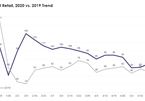Consumer demand and shopping behaviors have changed because of Covid-19. Even though strict social distancing has been lifted, online shopping demand has increased steadily since the beginning of the year. General goods and health care products grew most rapidly in the first half of the year.

The reports of iPrice Group and SimilarWeb showed that the number of visits to general goods websites increased by 41 percent, while the visits to make-up and health care product websites grew by 21 percent.
The online demand for health care and general goods is not temporary, according to iPrice. Covid-19 has helped create new online shopping habits, which will lead to long term growth in certain categories of products.
Meanwhile, fashion products continued to be gloomy with the number of visits in Q2 dropping by 29 percent compared with Q1. Mobile devices also saw a decrease of 13 percent. Only home appliances saw a growth rate of 10 percent.
The lower demand and the tightening of purse-strings by consumers have caused unessential goods to suffer.
General goods and fresh foods are the major items in e-commerce sites’ long-term competition strategies. They are leading to development of services such as logistics and transportation.
| Lazada in mid-April began providing fresh food with fast delivery (within two hours). Tiki in May introduced TikiNGON, the fresh food service with delivery within three hours. The competition in general goods distribution has become fierce. |
Lazada in mid-April began providing fresh food with fast delivery (within two hours). Tiki in May introduced TikiNGON, the fresh food service with delivery within three hours. The competition in general goods distribution has become fierce.
During the epidemic peak period, e-commerce websites reduced promotion and advertisement activities, but boosted sales through livestream and mobile games. These aimed to increase interactions and the number of users, taking full advantage of the social distancing period.
According to iPrice Group and App Annie, the total number of visits to online shopping apps in Vietna reached 12.7 billion, the highest level so far.
With the growth rate of 43 percent, Vietnam ranked third, after the Philippines and Thailand, in terms of growth. It was also among the top 3 in Southeast Asia, together with Indonesia and Thailand, in the number of visits to online shopping apps, accounting for 19.5 percent of the entire region market share.
In late 2019 and early 2020 e-commerce sites conducted intense experiments to develop online shopping. Tiki has TikiLive, Shopee has Shopee Feed, and Sendo has SenLive. The Covid-19 pandemic, which broke out in early 2020, gave a push to e-commerce sites as people stayed home and had higher demand for online entertainment, which was ideal for sites to experiment.
A report found that the number of transactions via mobile phones in Vietnam in H1 was 472 million, worth 4,900 trillion, increasing by 178 percent and 177 percent, respectively, compared with the same period last year.
According to Nielsen, 57 percent of Vietnamese are ready to use virtual reality technology to approach new products.
IPrice Group and App Annie reported that Shopee, Lazada, Tiki and Sendo were among the 10 most used online shopping apps in Q2.
Phuong Nguyen

Covid-19 pandemic gives big push to online shopping
Vietnam’s e-commerce saw a 30 percent growth rate from 2016 to 2020, according to the Ministry of Investment and Planning. The country aims to have 55 percent of population shopping online by 2025.

Vietnamese consumers turn to online shopping amidst COVID-19 pandemic
Criteo recently unveiled the results of its research analysing the impact of COVID-19 pandemic on the e-commerce landscape.